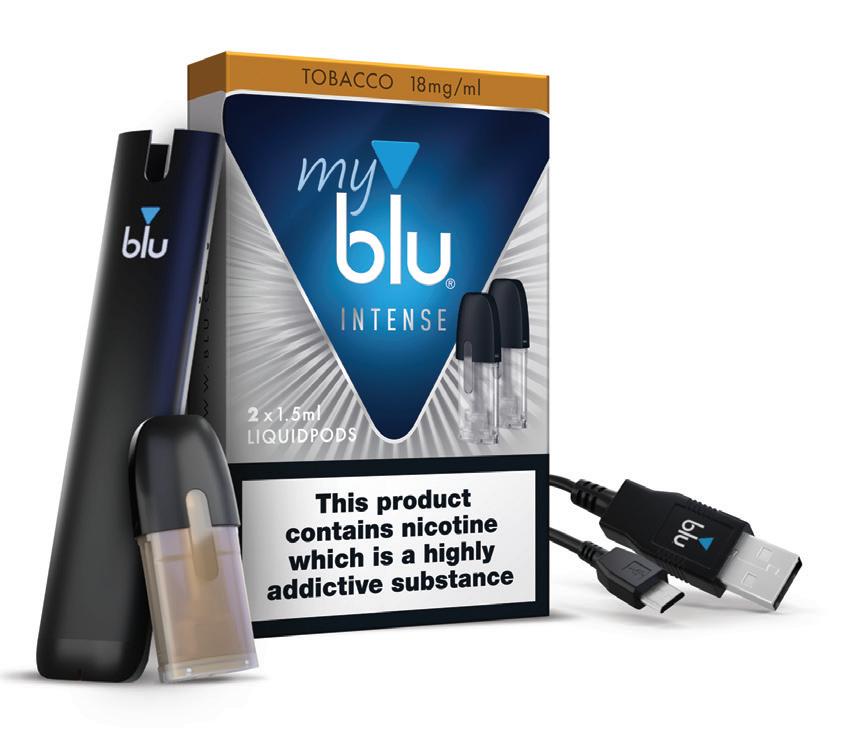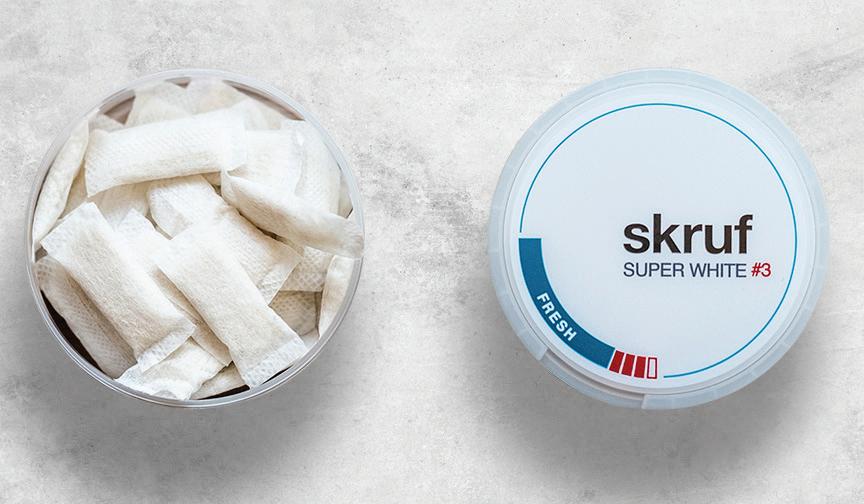
7 minute read
Imperial Brands Develops NGP “Belief System”
from Tobacco International - October/November 2019 • Tobacco Products International - Quarter 3, 2019
Imperial Brands Develops NGP “Belief System”
Advertisement
Provided by Imperial Brands
BELIEF 1: Product standards and science are of crucial importance
We believe it’s crucial for adult smokers and vapers to trust the products they choose to use. There are currently too many irresponsible players in the market, particularly in the vaping space. This is damaging the category and must be addressed.
In developing our NGPs, we are guided by comprehensive principles of design and quality, as well as strict manufacturing standards. We strongly believe that NGP standards need to rise significantly across the industry.
Any manufacturer must be able to stand scientifically, behind their products and be able to demonstrate that they operate to the highest standards of product stewardship.
We have over 300 scientists working on our Scientific Assessment Research Program; this program includes understanding:
• how smokers use our Next Generation Products;
• the chemical constituents of our NGPs and how levels compare to combustible tobacco products;
• the effects of using our products on the human body in clinical assessments. This program forms part of our growing PMTA dossier which will be submitted to the FDA in the coming months.
These types of assessments, and the teams of scientific experts required to carry them out, are major financial commitments, and in our view they should be mandatory.
We urge governments and regulators to play a key role in ensuring this aspiration becomes a reality to enable all of us in the industry to invest with confidence.
BELIEF 2: NGPs are for adult smokers only
We don’t target children; our marketing programs are focused solely on adult smokers and we are totally committed to enforcing and enhancing Youth Access Prevention measures.
Specifically, in the USA, we have an end-to-end Youth Access Prevention program to ensure our products are responsibly designed, packaged, marketed and sold. And we insist our retail and on-line partners make stringent commitments to prevent underage access, which we enforce through compliance oversight.
In our view, only companies committed to upholding the highest prevention standards for Youth Access & Youth Appeal should be allowed on the market.
BELIEF 3: Knowledge and learning must be invested in and shared
We believe it’s important to constantly improve our knowledge of the NGP categories. We focus on understanding long-term NGP use and encourage proactive, transparent intra-industry collaboration to address any data gaps.
We believe policy should be based on evidence, underpinned by good science and regulatory rigor. But we also recognize many NGPs are still evolving in scientific terms, and that long-term epidemiological data is something we must continue to pursue.
We acknowledge that no NGP is entirely risk-free, although both our ongoing research, and the broader scientific evidence base, suggest NGPs are potentially a lot less harmful than combustible cigarettes.
It’s so critical to be able to share knowledge and learnings; to enable credible conversations about the harm reduction potential of NGPs; and ensure appropriate regulation is implemented. This requires us to undertake the right scientific studies to better understand long term use, and to give everybody— regulators, public health bodies, the media and consumers—the opportunity to scrutinize the ensuing data.
This will take time, but we are playing our part with multiple studies: pre-clinical, clinical and behavioral across our whole NGP portfolio, either already published or in the pipeline.

BELIEF 4: Strong brands have an important role to play
We know that brands matter to smokers, so NGPs must have:
• brand values that resonate with smokers;
• a narrative that relates to who they are and how they feel about smoking.
Smokers trying blu can expect:
• A quality product underpinned by leading-edge science with over 10 years’ experience as America’s original vaping brand.
BELIEF 5: Smokers are not victims
Many smokers so far have not made the decision to try NGPs and we must respect that.
Taking the time to listen to smokers allows us really to understand their needs, and it enables us to develop effective strategies to help them define their own journeys in making a very personal choice to try an alternative to combustible cigarettes. We know that just shouting ‘Quit’ or ‘Switch’ at smokers is likely to have the opposite effect.
BELIEF 6: Flavors attract adult smokers to the category
They are important to the success of NGPs and a growing body of scientific research shows they play a fundamental role in attracting adult smokers to the category and keeping them there.
Our own research, which includes the views of 20,000 adult vapers in the USA, shows that the adult smoker’s journey to vaping often begins with familiar flavors like tobacco and menthol. However, the vast majority later progress to other flavors.
We simply cannot ignore the role that flavors play in attracting adult smokers to the category, but we need to ensure flavors are not marketed in a way that appeals to young people.
In our view, flavor bans are really not the answer. Unintended consequences of bans include:
• deterring smokers from trying vaping; or
• forcing a vaper back into smoking.
A ban on flavors can also lead to a growth in illicit trade, sub-standard and potentially dangerous counterfeit products that are not governed by any regulation.
As an industry, we should continue to work with regulators to co-develop guidelines on appropriate flavors that appeal to mature adult tastes, naming conventions, descriptors and associated marketing—all of which of course, must be complemented by initiatives and regulations that serve to prevent youth access.

BELIEF 7: A wide portfolio will help attract adult smokers into the NGP category
We are developing and expanding our NGP portfolio, which now includes vapor, oral tobacco and heated tobacco products.
BELIEF 8: Smokers need choice in their nicotine delivery
For NGPs to fulfill their harm reduction potential they have to provide smokers with genuine nicotine satisfaction.
In the USA, like other markets, there’s a range of nicotine levels available to suit individual smoker needs and we believe providing this choice is important.
At the lower end of the scale, in the UK, Public Health England and the Royal College of Physicians have said the current EU cap of 20mg on nicotine may limit the effectiveness of vapor as a smoking alternative, particularly for heavier smokers. We support the UK Government reviewing this arbitrary cap post Brexit
However, legislators also have a role to play, and we urge them to resist the temptation to treat this new category as a ‘cash cow’ revenue generator to plug budgetary shortfalls.
BELIEF 9: We must ensure the affordability of the NGP proposition
It is clear there has to be a strong value proposition to encourage smokers to try NGPs and there’s more work we, as an industry, can do to drive efficiencies and reduce production costs.
However, we don’t believe nicotine levels should be uncapped at the upper end; there should be a sufficient range to suit individual smoker needs—again, supported by science and the right regulatory framework.
Steep retail price hikes will severely constrain the uptake of NGP use among smokers. We’ve seen this before in markets such as Italy, where a few years ago, a big increase in excise duty led to a substantial reduction in vapor sales and with it a rise in sales of combustible cigarettes. When this excise increase was reversed, vapor returned to growth and cigarette sales declined.
We hope there are learnings here for other governments to take on board.
BELIEF 10: We should be able to use NGPs freely
Freedom and acceptance to use NGPs in public.
In Japan, consumers can use NGP products in many public places, and this has undoubtedly contributed to a nationwide reduction in smoking.
The UK government has recommended that transport providers and public places should treat combustible cigarettes and vaping products differently.
BELIEF 11: There needs to be freedom to communicate and educate
Freedom for the industry, public health bodies and others to communicate their potential benefits.
There should also be the freedom to honestly communicate and educate smokers about the potential harm reduction benefits of what is still an evolving, and sometimes misunderstood, product category. We also have a duty to remind Vapers to be courteous and sensitive to those around them. Cloud chasing does not have a great reputation.
We need consistent, accurate and proactive tobacco-harm-reduction communications from public health bodies, such as we’ve seen in the UK, where active public health campaigns communicate positive vapor messages. We believe this can—and should— serve as a “best practice” model for policy makers worldwide.
BELIEF 12: Innovation must be fostered
Recent advances in science and technology have provided us with the potential opportunity to facilitate tobacco harm reduction on an unprecedented global scale. True innovation never stops, and is underpinned by strong consumer insights and robust, fact-based science to validate harm reduction potential.
For example, we are excited by the potential of our connected device, which will empower smokers through real-time data—to enable their individual journeys, as well as the ability to lock out children from our products.
We hope the regulators globally will embrace, support and foster innovation, quickly.
BELIEF 13: We must achieve acceptance of NGPs’ potential for harm reduction
Tobacco harm reduction is the critical, unifying concept with the potential to have a dramatic impact on global public health.
We believe NGPs, and especially vaping products, have a significant role to play here. In the UK, for example, the incidence of smoking has fallen from 20.5 percent to 14 percent in the 10 years to 2018. In the USA, incidence has fallen to 13.4 percent over a similar period. In markets such as Thailand and Brazil, where EVP is banned, smoking incidence has only declined by 1 percent and 2 percent respectively in the same period.
Unfortunately, despite the strong evidence, the contribution NGPs can potentially make to tobacco harm reduction isn’t universally accepted, and a combination of mixed messages and misinformation means many smokers remain confused about the potential benefits of NGPs.
If we as an industry are serious about global tobacco harm reduction, we must work together to drive unified, fact-based conversation which delivers a consistent and accurate message.
This will ensure the company is better placed to meet ever-evolving consumer needs and deliver savings that can be reinvested in the growth of its portfolio of New Categories such as vapor, tobacco heating products and oral tobacco. [TI]







